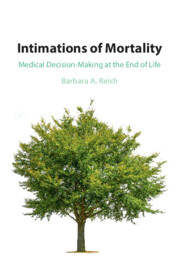Book contents
- Intimations of Mortality
- Intimations of Mortality
- Copyright page
- Dedication
- Contents
- Preface
- Acknowledgments
- 1 The Conundrum
- 2 The US Health Care ‘System’
- 3 Autonomy and Informed Consent in the Real World
- 4 The Denial of Death and Its Sequelae
- 5 Disorders of Consciousness and the Meaning of Life
- 6 More Barriers to Good Communication
- 7 Palliative and Hospice Care
- 8 Rational Apathy and the Role of Uncertainty
- 9 The Crucible
- 10 Resolving Conflicts at the End of Life
- 11 At the End of the Day
- 12 Coda
- Index
5 - Disorders of Consciousness and the Meaning of Life
Published online by Cambridge University Press: 10 March 2022
- Intimations of Mortality
- Intimations of Mortality
- Copyright page
- Dedication
- Contents
- Preface
- Acknowledgments
- 1 The Conundrum
- 2 The US Health Care ‘System’
- 3 Autonomy and Informed Consent in the Real World
- 4 The Denial of Death and Its Sequelae
- 5 Disorders of Consciousness and the Meaning of Life
- 6 More Barriers to Good Communication
- 7 Palliative and Hospice Care
- 8 Rational Apathy and the Role of Uncertainty
- 9 The Crucible
- 10 Resolving Conflicts at the End of Life
- 11 At the End of the Day
- 12 Coda
- Index
Summary
Patients in a permanent vegetative state (PVS) exist in the netherworld between life and death. They breathe independently, their hearts beat without assistance, and their bodies are warm to the touch. With medical support, these patients can live for many years. Yet, consciousness, the sine qua non of human existence, is irrevocably lost. These patients cannot and never will again see, feel, and respond to the world around them. Their capacity for love is gone, their ability to communicate is gone, and they remain entirely dependent on medical care for their bodily needs. Patients in PVS require artificial nutrition and hydration because they can no longer ingest food and fluids by mouth. They require bathing, turning, and cleaning of bodily waste because they can no longer perform these basic activities of self-care. Modern medicine can keep the motor running, but the patient remains in neutral – a physical vessel now lacking the spark of consciousness.
Keywords
- Type
- Chapter
- Information
- Intimations of MortalityMedical Decision-Making at the End of Life, pp. 87 - 106Publisher: Cambridge University PressPrint publication year: 2022

